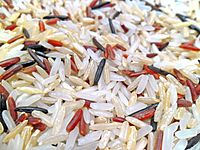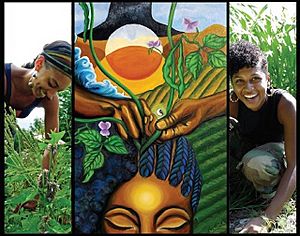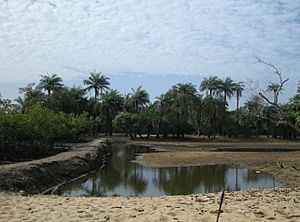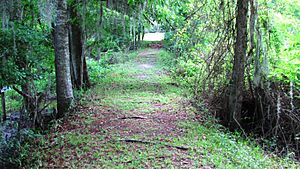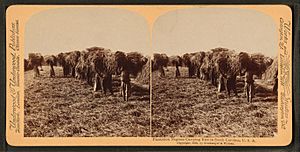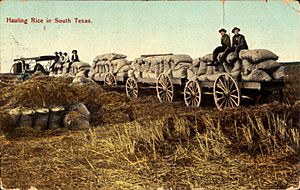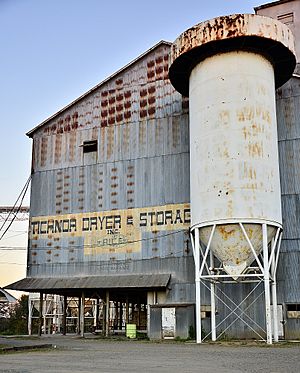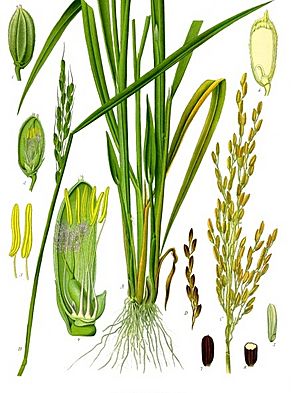Rice production in the United States facts for kids
Rice production is a big part of farming in the United States. It's the third largest crop among grains, right after corn and wheat. Growing rice needs a lot of money for equipment and land, and it has the highest land rental costs in the country.
All rice fields in the US need irrigation (extra water). From 2000 to 2009, about 3.1 million acres of land grew rice. This was expected to grow to about 3.3 million acres in the next ten years. The main states that grow rice are Arkansas, California, Louisiana, Mississippi, Missouri, and Texas.
Contents
History of Rice Farming
How Rice Came to America

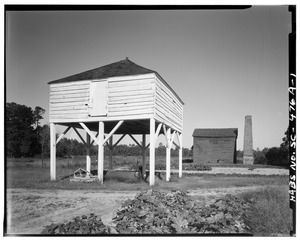
There are two main types of rice: African rice and Asian rice. African rice was first brought to the United States in the 1600s. However, a type of Asian rice called "Carolina rice" became very popular in America. It was already well-known in Europe.
Records show rice was grown in Virginia as early as 1609. Later, in 1685, a special type of Asian rice from Madagascar called "Gold Seede" was given to Dr. Henry Woodward.
Rice and Enslaved People
The colonies of South Carolina and Georgia became very rich from growing Asian rice. This was possible because of the forced labor and amazing knowledge of enslaved people from West Africa, especially from areas like Senegambia and Sierra Leone. These people came from regions where rice was already grown. They knew how to plant, grow, and harvest rice, which was vital for the success of rice farms in America.
Enslaved Africans cleared the land, built walls called dikes in the wet areas, and created irrigation systems. They knew how to use the tides to bring fresh water to the fields and control the water levels as the rice grew. They planted, hoed, and harvested rice using hand tools.
At first, rice was processed by hand using wooden tools. Then, it was cleaned using special baskets made from sweetgrass, a skill also brought from Africa. Later, the invention of the rice mill and the use of water power made it much easier and faster to process rice.
Growing rice was very difficult and dangerous work. Enslaved people often worked in deep water under the hot sun. They faced poor living conditions, diseases like malaria, and harsh treatment. Despite these terrible conditions, enslaved people were incredibly productive. Their hard work made rice plantations very profitable for their owners.
Many plantations used a "task system." Enslaved people were given specific tasks to complete each day. Once their tasks were done, they could use the rest of the day for themselves, often to grow their own food or make clothes. This system, along with the difficult conditions in rice-growing areas, helped keep some African traditions alive among the Gullah people.
For almost 190 years, most rice in the US was grown in South Carolina and Georgia. Some was also grown in North Carolina, Florida, Alabama, Mississippi, and Louisiana.
Changes in the 1800s
In the mid-1800s, rice farming started in Louisiana and eastern Texas. Meanwhile, the soil in the older eastern rice fields became less fertile.
When enslaved people were freed in 1863, rice farming on the East Coast became less profitable because it relied on their forced labor. It was hard, skilled work done in very unhealthy places. Even with new machines, it was too late. A series of hurricanes in the late 1800s damaged the water systems and ended the rice industry in the Carolinas. Rice production then moved to the Deep South, where the land was better for using machines.
For example, in 1839, the US produced over 80 million pounds of rice, with most of it from South Carolina and Georgia. By 1870, after enslaved people were freed, production dropped. But by 1879, it was rising again, reaching over 110 million pounds.
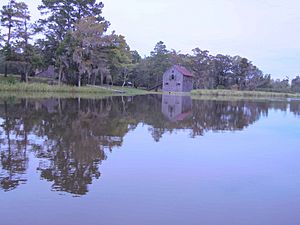
Between 1890 and 1900, Louisiana and Texas greatly increased their rice fields. They soon produced almost 75% of the country's rice. The rice industry in Louisiana grew a lot after 1884. This was because a new area in the southwestern part of the state opened up. Also, new irrigation and farming methods allowed farmers to use harvesting machines, like those used for wheat. This greatly lowered the cost of growing rice.
From 1900 to Today
Rice farming began in Arkansas in 1904 and in California in 1912. In California, rice was first grown for the Chinese workers who came during the California Gold Rush. But large-scale farming for everyone started in 1912 in Richvale, California. By 2006, California was the second-largest rice producer in the US.
After the early 1900s, rice farming in the Southeast became less profitable and eventually stopped. Today, you can visit the historic Mansfield Plantation in South Carolina. It's the only remaining rice plantation with its original buildings for processing rice. A special type of rice called "Carolina Gold," which came from Africa, was once very popular there. Farmers are now trying to grow it again.
In 1900, the US produced about half the rice it ate. The main types of rice grown were "gold seed rice" and "white rice." Gold seed rice gave more grain, so it became more common.
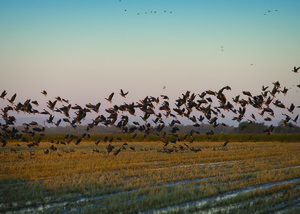
Today, California grows a lot of rice, especially short and medium-grain types. By 2006, it was the second-biggest rice producer after Arkansas. Most of California's rice is grown in six counties north of Sacramento.
In 2012, the US produced about 19.9 billion pounds of rice, which was 8% more than in 2011. The amount of land used for rice also grew.
Six states now grow over 99% of all rice in the US: Arkansas, California, Louisiana, Mississippi, Missouri, and Texas. In 2003, Arkansas was number one, producing 213 million bushels of rice.
Types of Rice Grown
The first types of rice grown in South Carolina were African Oryza glaberrima and the special "Carolina Gold." No one knows exactly how Carolina Gold, which is thought to be from Southeast Asia, came to the US.
After rice farming stopped in South Carolina, "Carolina Gold" is now grown in Texas, Arkansas, and Louisiana.
In California, farmers mostly grow short and medium-grain japonica varieties. One popular type is Calrose, which makes up about 85% of California's rice crop.
Globally, over 100 types of rice are grown. In the US, about 20 types are grown for sale, mainly in Arkansas, Texas, Louisiana, Mississippi, Missouri, and California. Rice is generally grouped into three main types:
- Long-grain rice: This rice is thin and long.
- Medium-grain rice: This rice is plump but not round.
- Short-grain rice: This rice is round.
Rice also comes in different forms like brown rice, parboiled rice, and regular white rice.
In the US, about 58% of rice is used as food for people. Another 16% is used in food products and beer, and 10% goes into pet food.
Special types of rice, like jasmine rice and basmati rice, are known for their smell. These are mostly imported from Thailand, India, and Pakistan because they are not grown much in the US.
How Rice is Processed
After rice is harvested, it goes through a milling process to remove the outer shell, called the husk. First, the rice is cleaned to remove any dirt or plant pieces. For parboiled rice, the rice is steamed under pressure before milling. After drying, the husk is removed, and then the rice is polished.
Brown rice is made by just removing the husk. It keeps the healthy bran layer around the kernel. For white rice, both the husk and the bran are removed, and the kernels are polished to make them smooth and white.
Rice Exports
The first rice exported from Carolina was a small amount in 1698. This grew to 330 tons by 1700 and jumped to 42,000 tons in 1770. Famous French chefs helped make Carolina rice popular in France. However, after enslaved labor was abolished, rice exports from Carolina eventually stopped.
The US produces about 2% of the world's rice. But it exports about 10% of all rice traded globally. Most of the exported rice is high-quality long-grain and medium/short-grain varieties. The US exports different forms of rice, including rough (unmilled) rice, parboiled rice, brown rice, and fully milled rice.
The US exports rice to many countries, including Mexico, Central America, Northeast Asia, the Caribbean, the Middle East, Canada, and parts of Europe and Africa. The rice exported from the US is free of genetically modified (GM) rice. Trade agreements like the World Trade Organization (WTO) and the North American Free Trade Agreement (NAFTA) have helped increase US rice exports since the 1990s.
Rice Culture

A popular tradition on New Year's Day, especially in the southern US, is eating a rice dish called "Hoppin' John." This dish is often eaten with the belief that it brings good luck for the new year.
The International Rice Festival is held every year in Crowley, Louisiana. It takes place on the third weekend of October. This festival is the largest and oldest farming festival in Louisiana. It celebrates rice as an important food and its economic value around the world. The festival started in 1927 as a "Rice Carnival."



